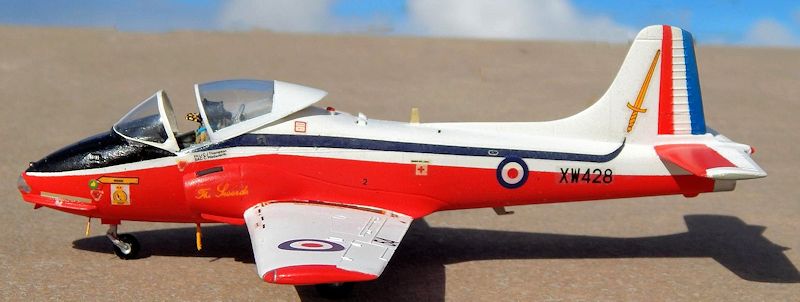
Airfix 1/72 Jet Provost T.5
| KIT #: | ? |
| PRICE: |
|
| DECALS: | Two options |
| REVIEWER: | Carmel J. Attard |
| NOTES: |
Pavla upgrade sets and Modeldecals used |

| HISTORY |
The British Aerospace Jet Provost Mk5 is a revised refined version of
the earlier Mk3 and 4 and operated exclusively with the RAF Training Command. It
provided basic tuition in a side-by-side e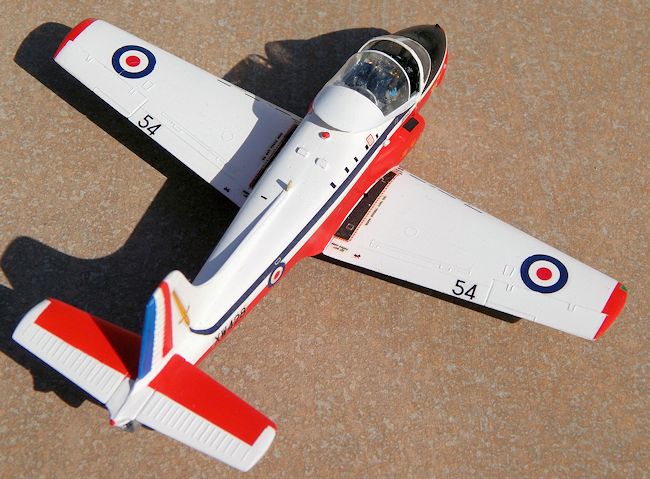 nvironment. Delivery of 110 aircraft
to the RAF was completed in October 1972. Most Jet Provost in the training role
had a straight forward career first at the RAF College Cranwell and then at
Linton-On-Ouse. The Jet provost Mk5 formed part of a number of RAF aerobatic
teams and these include the Linton Blades, Red Pelicans, and The Swords, besides
other solo display aircraft.
nvironment. Delivery of 110 aircraft
to the RAF was completed in October 1972. Most Jet Provost in the training role
had a straight forward career first at the RAF College Cranwell and then at
Linton-On-Ouse. The Jet provost Mk5 formed part of a number of RAF aerobatic
teams and these include the Linton Blades, Red Pelicans, and The Swords, besides
other solo display aircraft.
The Jet Provost Mk5 represented in this kit built markings belongs to
The Swords aerobatic team based at RAF Leeming in July 1974. The team was led by
Flt.Lt.C.J Thompson whose name was appears on TW428 ‘54’. During their existence
The Swords used several different machines, four of these are represented in the
sheet and these are:
XW428 coded 54 flown by Flt Lt. C.J.Thompson; XW407 flown coded 50 flown
by Flt Lt. R.D.Thomas; XW424 coded 52 flown by Flt Lt. M.A. Fox who flew the No3
machine from the right-hand seat, and the crew names were accordingly presented
on the starboard side. Another T5 operated by the Swords was XW426 coded 53 and
flown by Flt Lt.J.D. Aldington.
| THE KIT |
Moulded in white styrene the kit has parts for either of two versions.
Kit contains around 90 parts, which include alternative parts like wing tip
tanks, under wing tanks and wing pylons and stores. The Jet Provost T Mk5
carried no wing tip tanks and has markings for The Red Pelicans aerobatic team
finished in red, white and light aircraft grey, trainer scheme. Notwithstanding,
the kit makes up into an
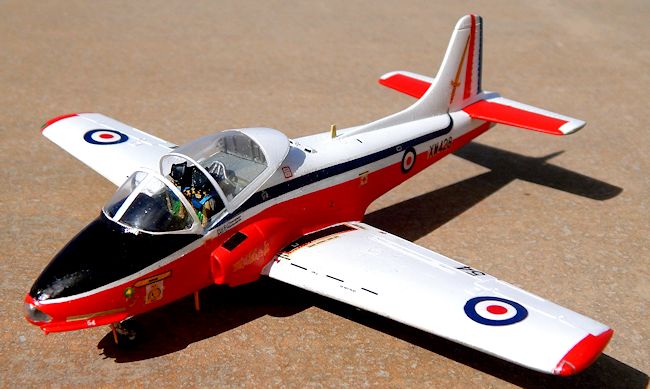 excellent model of the Jet Provost T5. Surface detail
such as panel lines and rivets are well reproduced though they are in raised
form instead of engraved or flush.
excellent model of the Jet Provost T5. Surface detail
such as panel lines and rivets are well reproduced though they are in raised
form instead of engraved or flush.
All parts fit together very well and only trace of filler being required
on the main wing and tail wing roots to fuselage joint. One really has to pack
the nose with lead weight and ensure that it will not become loose. Alternative
parts are provided for a Strikemaster. The differences are not major and are
limited to wing tip tanks, underwing stores and different details such as
aerials. My Jet Provost kit build includes the Pavla detail set, as well as
decals that came from Modeldecal set No28.
The Pavla resin set consist of two detailed ejection seats, cockpit
coming complete with a full instrument panel, two sets of rudder pedals, two
control columns which a lot more accurate and detailed than those found in the
Airfix kit, Port and Starboard side panels are complete with embossed details
and a cockpit floor complete with central console and a detailed back plate /coaming.
There is also a vac form clear cockpit canopy complete with a resin detail part
that integrates with the sliding canopy part if it is fixed in open position.
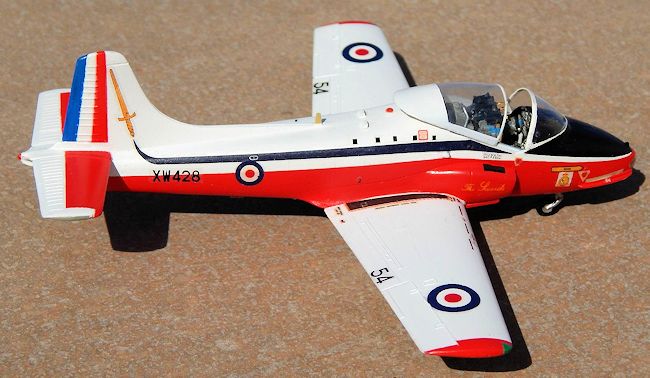 The set comes complete with two A5 size pages of assembly drawings and
guide to show which parts of the forward fuselage required to alter so that the
complete office resin detail parts fit snugly. Other drawings indicate the
colours that go on each resin item.... seats, instruments, panels etc.
The set comes complete with two A5 size pages of assembly drawings and
guide to show which parts of the forward fuselage required to alter so that the
complete office resin detail parts fit snugly. Other drawings indicate the
colours that go on each resin item.... seats, instruments, panels etc.
Model decal set No 28 has two photos of the Jet Provost Mk5 from the
Swords team, based at Leeming, UK. Four are included in the set so that any one
can be selected. The open position of the cockpit canopy encourages one to
straightforward super detailing the Airfix kit. 4-view detail drawings indicate
the exact position of each decal item on the model. The T5 has a colourful
livery of gloss light grey wings, gloss red lower half of fuselage and white
top. There are around 40 decal items that cover any of the four in the team. Kit
decals are also indicated with letter ‘Z’ so that there is no repetition.
| CONSTRUCTION |
Before going by the Airfix kit instructions, I have sawn off the cockpit
coaming and the rear part of cockpit deck. These are accurately shown as shaded
areas A in the Pavla instructions. The embossed locating guide parts inside the
cockpit are also filed down. The above applies to both sides of the kit fuselage
halves. The cockpit needed to be assembled first. Cockpit floor with back plate,
and side consoles are first pre-painted and fitted in place. The seats are then
slid in their respective spot making sure that the seat to go on the port is
fixed in its right place since the seats differ from each other at their top
part. The rudder pedals and control sticks are also added and the cockpit
coaming and 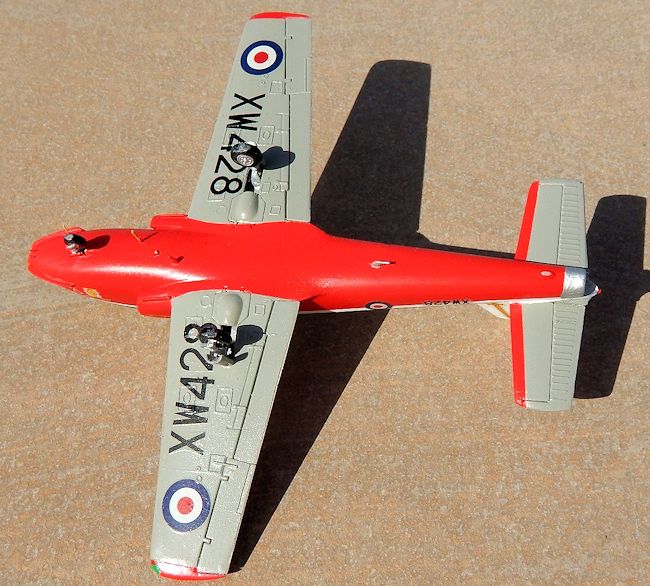 instruments are fixed at the end. Already the detailed cockpit will
cause one to make a second glance and to me it has an elegance that was somewhat
lacking in the kit if built straight from the box.
instruments are fixed at the end. Already the detailed cockpit will
cause one to make a second glance and to me it has an elegance that was somewhat
lacking in the kit if built straight from the box.
The vac form clear cockpit canopy pieces are carefully cut with a sharp
blade and trimmed a little at a time at the periphery until the canopy frame has
arrived to the best fit or seating. The two canopy parts were then set aside and
their frame painted white upon careful masking with Tamiya tape. The rest of
assembly went in accordance to kit instructions adding sufficient lead weight to
the nose so that the model will balance on the nose wheel in the end.
No wing pylons and wing racks added and rounded wing tips were fixed
instead of tip tanks. A whip aerial and a mast aerial were fixed under the
forward fuselage. Two narrow streaks were added right under the air intakes,
which were made from thin plastic card strips. The nose front Perspex was also
cut from Pavla set and it looked so much more realistic than if the kits clear
part was used. The wing undercarriage legs were lengthened by 1mm while the
vertical doors were reduced slightly in height so that the torque link just
stays visible as caught in pictures of the real aircraft.
| COLORS & MARKINGS |
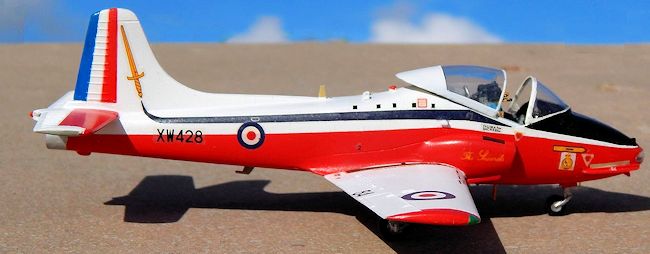 The Swords Jet provost T5 wore the basic RAF trainer scheme as mentioned
earlier and the blue trim and sword motif issued with the Modeldecal sheet added
more colour and life to the team aircraft. In spite of age the decals seemed to
retain good adhesion properties. The interior was cockpit medium grey, seats
being black with drab cushions and blue seat straps. Ejector seat pull handles
painted in yellow and black. Roundels and other standard markings are kit
decals.
The Swords Jet provost T5 wore the basic RAF trainer scheme as mentioned
earlier and the blue trim and sword motif issued with the Modeldecal sheet added
more colour and life to the team aircraft. In spite of age the decals seemed to
retain good adhesion properties. The interior was cockpit medium grey, seats
being black with drab cushions and blue seat straps. Ejector seat pull handles
painted in yellow and black. Roundels and other standard markings are kit
decals.
| CONCLUSIONS |
The model was something of a challenge to build because of the tiny
detail parts that also took time and a lot of patience to paint. Still I enjoyed
the work involved especially that the end result looks quite a neat and detailed
replica.
| REFERENCES |
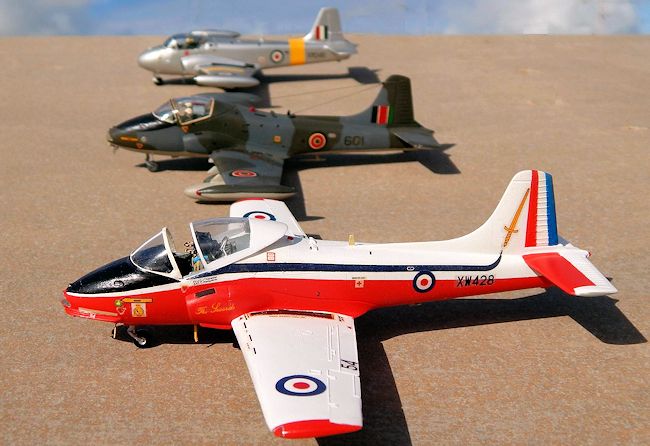 1) Scale Aircraft Modelling Vol 17 No 9 November 1995 scale plans.
1) Scale Aircraft Modelling Vol 17 No 9 November 1995 scale plans.
2) Modeldecal set 28 instructions.
January 2014
If you would like your product reviewed fairly and fairly quickly, please contact the editor or see other details in the Note to Contributors.